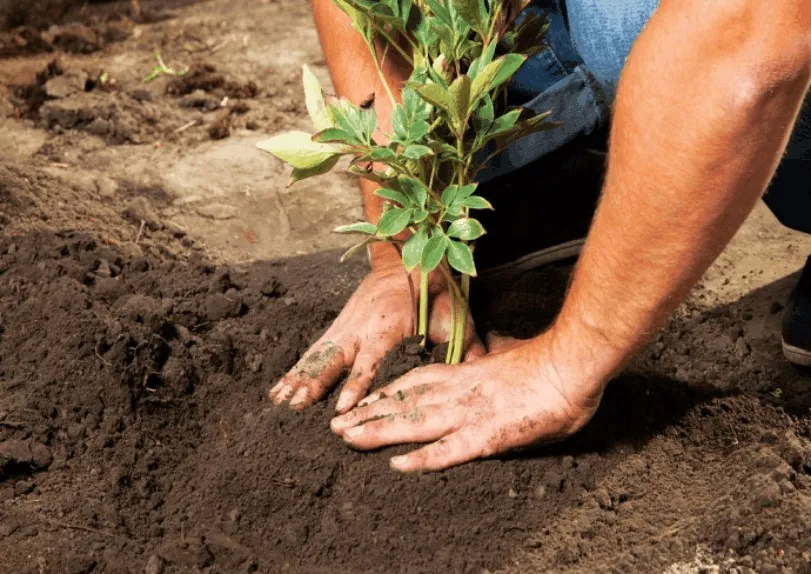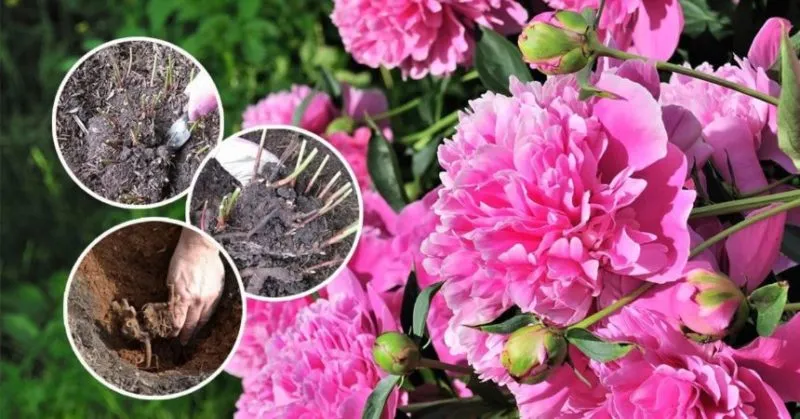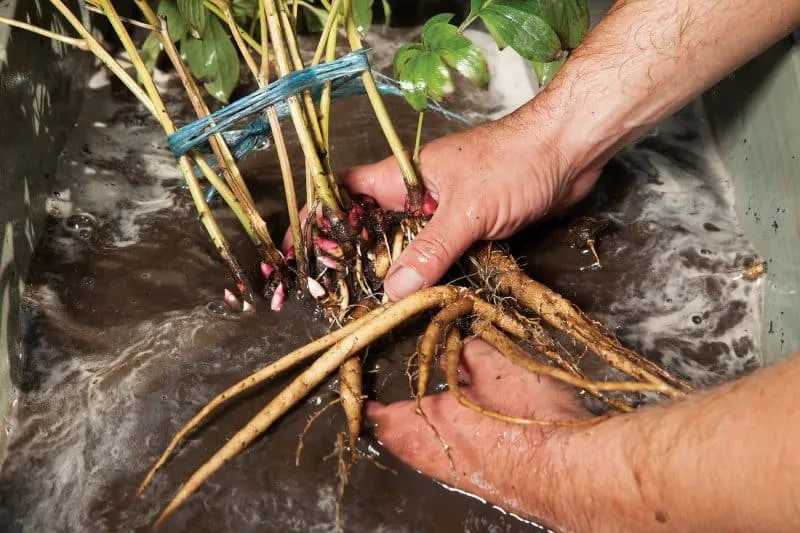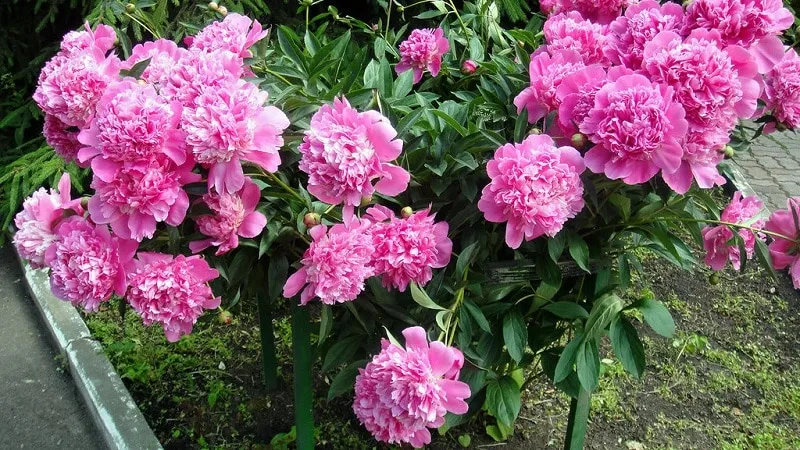Peonies are perennial plants that adorn gardens with large, fragrant blooms. Proper planting and care ensure their longevity and health. In favorable conditions, peonies can thrive for decades, but occasionally, they need to be transplanted. Here’s how to transplant peonies in August to a new location and how to divide them correctly.
Table of contents
Can You Transplant Peonies in August?
Peonies are long-lived plants that can grow in one spot for over 10 years without needing to be moved. Gardening literature describes cases where peonies flourished for 40–50 years, blooming abundantly each season. However, most bushes lose their vitality after 5–7 years. The root collar becomes a haven for slugs, worms, and ants, while flower buds form too deep, leading to fewer blooms. These are the first signs of aging, indicating it’s time to transplant the plant.

The best time for transplanting is after flowering, in August. By summer, the plant has stored enough nutrients for winter survival.
Ideal transplanting periods:
- Central Europe — August 20 – September 20
- Northern Europe (Scandinavia, Baltic states) — Mid-August – Mid-September
- Southern Europe — September 15 – October 25
Reasons to transplant peonies:
- Diseases, root rot, or pest infestations on leaves and buds;
- Shading due to overgrown bushes or trees;
- Depleted soil leading to delayed or absent flowering.
Spots on upper leaves and yellowing foliage near the roots indicate that peonies need a new location.
How to Transplant Peonies in August to a New Location

Choose a sunny spot — peonies thrive in sunlight and struggle in shade. An ideal location is an elevated, wind-protected area with good drainage. Avoid waterlogged soil, as excess moisture causes root rot.
The soil should be fertile and well-aerated. Loamy soil with neutral acidity works best. To improve fertility, add well-rotted manure and peat. Heavy clay soil can be loosened with river sand.
Avoid planting peonies under large trees or dense shrubs, as shade reduces blooming.
Tip! Pair peonies with lilies, clematis, phlox, delphiniums, or irises for a stunning flower bed.
Prepare the new site a month before transplanting. Dig holes 60–70 cm deep, add a drainage layer (broken bricks, pebbles, or expanded clay), and fill with fertile soil. You can use store-bought soil or make your own mix: 10 kg peat, 10 kg compost, 10 kg river sand, 50 g superphosphate, and 200 g wood ash.
How to Dig Up Peonies
Before digging, trim the stems to ground level with sharp pruners. Leave some foliage to sustain the plant.
Use a fork to loosen the soil around the bush, then gently lift it. Some root loss is normal. Rock the bush back and forth while holding the stems, then carefully remove it.
Shake off excess soil or rinse the roots with a hose. Let the plant sit in shade for 3–5 hours to allow the roots to firm up, making division easier.
How to Divide the Bush
Divide the bush by hand or cut the rhizome with a sterilized knife. Preserve the buds during division.
Optimal root length is 15–20 cm, with 3–5 buds per division. Trim long roots for easier planting.
Inspect the rhizome, remove rotten parts, and treat cuts with crushed charcoal, antiseptic, or a manganese solution. Soak roots for 30 minutes in a fungicide like "Fongarid" or "Teldor."
For root stimulation, use rooting hormones like "Root Boost" or "Clonex." For extra protection, dip roots in a clay slurry: mix clay with water to a thick consistency and add copper sulfate (50 g per 10 L).
Planting Peonies in Open Ground
Transplant whole bushes without division by keeping the root ball intact. Bury buds no deeper than 5 cm. Fill the hole with soil, level it, and water with a manganese solution.
Place plants in the center of the hole and cover with soil. Small divisions go vertically; larger ones can be angled. Water thoroughly and mulch with bark, sawdust, or peat.
Post-Transplant Care for Peonies

After transplanting, peonies need careful attention to adapt successfully.
Avoid watering or fertilizing for the first two weeks. Then, water deeply 1–2 times weekly (10–15 L per bush). Surface watering only moistens the topsoil, leaving roots thirsty.
Note! Larger plants need more water. During droughts, water every other day and loosen the soil.
After August transplanting, avoid nitrogen fertilizers—they promote foliage over flowers and reduce winter hardiness. Phosphorus and potassium fertilizers can be added after 2–3 years. Initially, peonies rely on nutrients from the planting hole.
As temperatures drop, prepare for winter: cut stems to the ground, cover with straw, peat, or leaves. In harsh climates, use conifer branches or garden fleece.
Why Peonies Don’t Bloom After Transplanting
Common reasons for non-flowering after transplanting:
- Planting too deep. Buds should sit 3–5 cm below soil. Without proper drainage, they may sink deeper, delaying blooms for years.
- Lack of water or nutrients. Poor soil prep or competition from nearby trees/bushes starves peonies.
- Insufficient sunlight. Peonies need full sun or light shade to bloom.
- Old divided bushes may take years to recover and flower.
- Untrimmed thick roots during division slows bud formation.
- Waterlogged soil rots roots; rodents or insects may also damage them.
- Transplanting in spring instead of late summer disrupts the cycle.
- Overly small divisions without buds won’t flower.
- Patience needed. Flowers may take 2+ years post-transplant.
- Winter damage kills flower buds.
- Premature pruning. Cut peonies in late autumn only.
- Excess nitrogen boosts leaves, not blooms.
Avoid highly acidic or alkaline soil—ideal pH is 6.5.
Conclusion
Transplant peonies in August or early autumn if soil fertility declines, blooms diminish, or shade increases. Dividing mature bushes rejuvenates them.
Select sunny, well-drained spots with neutral, fertile soil. Post-transplant, allow time for adaptation and maintain consistent moisture. With care, your peonies will thrive for decades.







